Wind Energy: Turbine Types, Efficiency, and Shrouded Turbine Report
VerifiedAdded on 2019/09/20
|9
|2348
|2602
Report
AI Summary
This report provides a comprehensive overview of wind energy, a crucial renewable energy source. It begins with an introduction to wind energy's historical and current significance, highlighting its environmental benefits and growing global adoption. The report then delves into the classification of wind turbines based on axis of rotation and scale, differentiating between vertical and horizontal axis turbines, as well as large and small-scale systems. A detailed literature review explores key terminologies related to wind energy and turbine design, including power coefficients, Betz's Law, and torque coefficients. The core of the report focuses on shrouded turbines, particularly diffuser augmented wind turbines (DAWTs), analyzing their advantages such as increased energy extraction and reduced noise pollution, while also addressing limitations like complex manufacturing and potential vibration issues. The study aims to assess the performance of shrouded turbines, comparing them to conventional designs and exploring potential efficiency improvements. The report concludes by summarizing the benefits and challenges associated with the adoption of shrouded turbines, providing valuable insights for future research and development in wind energy technology.
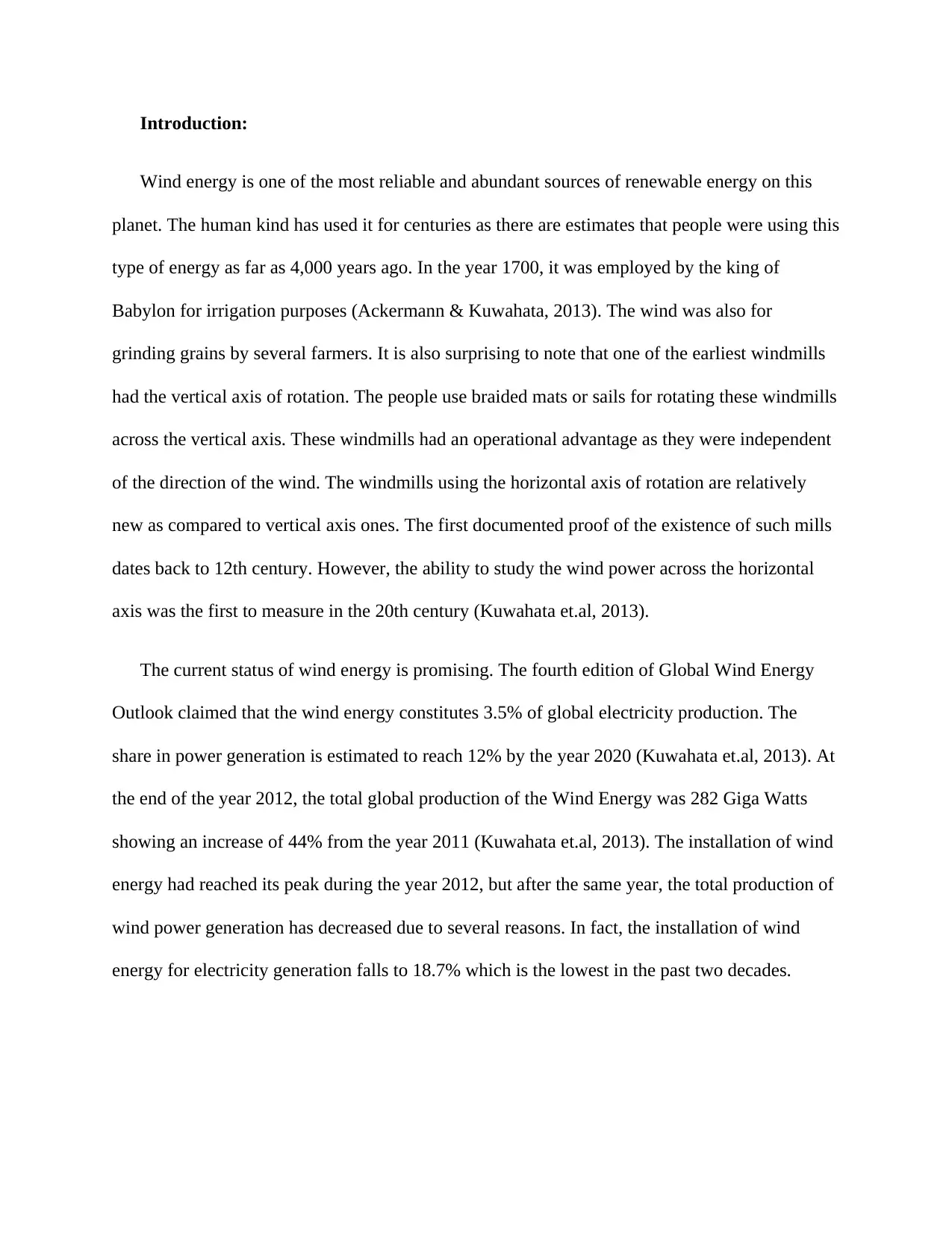
Introduction:
Wind energy is one of the most reliable and abundant sources of renewable energy on this
planet. The human kind has used it for centuries as there are estimates that people were using this
type of energy as far as 4,000 years ago. In the year 1700, it was employed by the king of
Babylon for irrigation purposes (Ackermann & Kuwahata, 2013). The wind was also for
grinding grains by several farmers. It is also surprising to note that one of the earliest windmills
had the vertical axis of rotation. The people use braided mats or sails for rotating these windmills
across the vertical axis. These windmills had an operational advantage as they were independent
of the direction of the wind. The windmills using the horizontal axis of rotation are relatively
new as compared to vertical axis ones. The first documented proof of the existence of such mills
dates back to 12th century. However, the ability to study the wind power across the horizontal
axis was the first to measure in the 20th century (Kuwahata et.al, 2013).
The current status of wind energy is promising. The fourth edition of Global Wind Energy
Outlook claimed that the wind energy constitutes 3.5% of global electricity production. The
share in power generation is estimated to reach 12% by the year 2020 (Kuwahata et.al, 2013). At
the end of the year 2012, the total global production of the Wind Energy was 282 Giga Watts
showing an increase of 44% from the year 2011 (Kuwahata et.al, 2013). The installation of wind
energy had reached its peak during the year 2012, but after the same year, the total production of
wind power generation has decreased due to several reasons. In fact, the installation of wind
energy for electricity generation falls to 18.7% which is the lowest in the past two decades.
Wind energy is one of the most reliable and abundant sources of renewable energy on this
planet. The human kind has used it for centuries as there are estimates that people were using this
type of energy as far as 4,000 years ago. In the year 1700, it was employed by the king of
Babylon for irrigation purposes (Ackermann & Kuwahata, 2013). The wind was also for
grinding grains by several farmers. It is also surprising to note that one of the earliest windmills
had the vertical axis of rotation. The people use braided mats or sails for rotating these windmills
across the vertical axis. These windmills had an operational advantage as they were independent
of the direction of the wind. The windmills using the horizontal axis of rotation are relatively
new as compared to vertical axis ones. The first documented proof of the existence of such mills
dates back to 12th century. However, the ability to study the wind power across the horizontal
axis was the first to measure in the 20th century (Kuwahata et.al, 2013).
The current status of wind energy is promising. The fourth edition of Global Wind Energy
Outlook claimed that the wind energy constitutes 3.5% of global electricity production. The
share in power generation is estimated to reach 12% by the year 2020 (Kuwahata et.al, 2013). At
the end of the year 2012, the total global production of the Wind Energy was 282 Giga Watts
showing an increase of 44% from the year 2011 (Kuwahata et.al, 2013). The installation of wind
energy had reached its peak during the year 2012, but after the same year, the total production of
wind power generation has decreased due to several reasons. In fact, the installation of wind
energy for electricity generation falls to 18.7% which is the lowest in the past two decades.
Paraphrase This Document
Need a fresh take? Get an instant paraphrase of this document with our AI Paraphraser
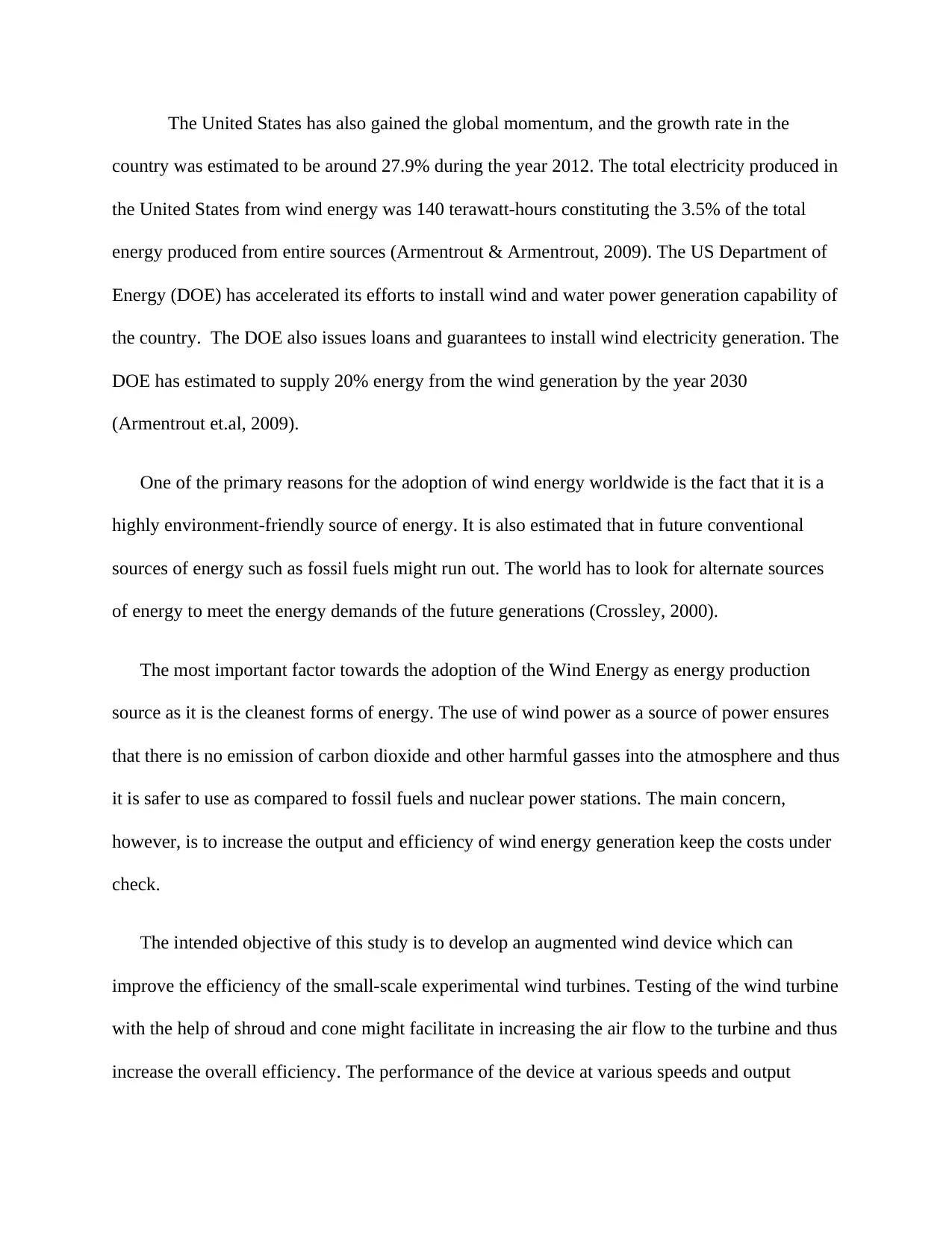
The United States has also gained the global momentum, and the growth rate in the
country was estimated to be around 27.9% during the year 2012. The total electricity produced in
the United States from wind energy was 140 terawatt-hours constituting the 3.5% of the total
energy produced from entire sources (Armentrout & Armentrout, 2009). The US Department of
Energy (DOE) has accelerated its efforts to install wind and water power generation capability of
the country. The DOE also issues loans and guarantees to install wind electricity generation. The
DOE has estimated to supply 20% energy from the wind generation by the year 2030
(Armentrout et.al, 2009).
One of the primary reasons for the adoption of wind energy worldwide is the fact that it is a
highly environment-friendly source of energy. It is also estimated that in future conventional
sources of energy such as fossil fuels might run out. The world has to look for alternate sources
of energy to meet the energy demands of the future generations (Crossley, 2000).
The most important factor towards the adoption of the Wind Energy as energy production
source as it is the cleanest forms of energy. The use of wind power as a source of power ensures
that there is no emission of carbon dioxide and other harmful gasses into the atmosphere and thus
it is safer to use as compared to fossil fuels and nuclear power stations. The main concern,
however, is to increase the output and efficiency of wind energy generation keep the costs under
check.
The intended objective of this study is to develop an augmented wind device which can
improve the efficiency of the small-scale experimental wind turbines. Testing of the wind turbine
with the help of shroud and cone might facilitate in increasing the air flow to the turbine and thus
increase the overall efficiency. The performance of the device at various speeds and output
country was estimated to be around 27.9% during the year 2012. The total electricity produced in
the United States from wind energy was 140 terawatt-hours constituting the 3.5% of the total
energy produced from entire sources (Armentrout & Armentrout, 2009). The US Department of
Energy (DOE) has accelerated its efforts to install wind and water power generation capability of
the country. The DOE also issues loans and guarantees to install wind electricity generation. The
DOE has estimated to supply 20% energy from the wind generation by the year 2030
(Armentrout et.al, 2009).
One of the primary reasons for the adoption of wind energy worldwide is the fact that it is a
highly environment-friendly source of energy. It is also estimated that in future conventional
sources of energy such as fossil fuels might run out. The world has to look for alternate sources
of energy to meet the energy demands of the future generations (Crossley, 2000).
The most important factor towards the adoption of the Wind Energy as energy production
source as it is the cleanest forms of energy. The use of wind power as a source of power ensures
that there is no emission of carbon dioxide and other harmful gasses into the atmosphere and thus
it is safer to use as compared to fossil fuels and nuclear power stations. The main concern,
however, is to increase the output and efficiency of wind energy generation keep the costs under
check.
The intended objective of this study is to develop an augmented wind device which can
improve the efficiency of the small-scale experimental wind turbines. Testing of the wind turbine
with the help of shroud and cone might facilitate in increasing the air flow to the turbine and thus
increase the overall efficiency. The performance of the device at various speeds and output
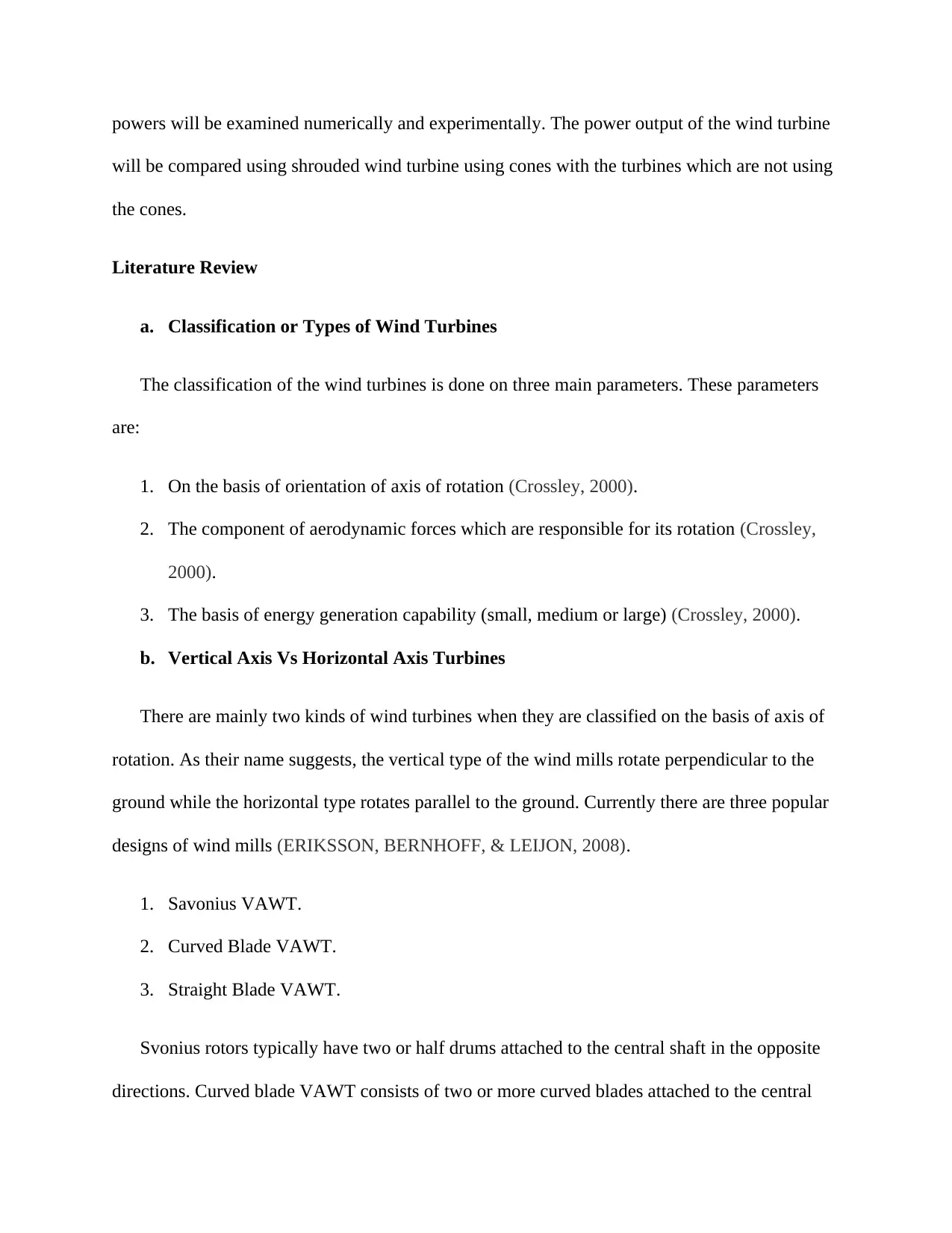
powers will be examined numerically and experimentally. The power output of the wind turbine
will be compared using shrouded wind turbine using cones with the turbines which are not using
the cones.
Literature Review
a. Classification or Types of Wind Turbines
The classification of the wind turbines is done on three main parameters. These parameters
are:
1. On the basis of orientation of axis of rotation (Crossley, 2000).
2. The component of aerodynamic forces which are responsible for its rotation (Crossley,
2000).
3. The basis of energy generation capability (small, medium or large) (Crossley, 2000).
b. Vertical Axis Vs Horizontal Axis Turbines
There are mainly two kinds of wind turbines when they are classified on the basis of axis of
rotation. As their name suggests, the vertical type of the wind mills rotate perpendicular to the
ground while the horizontal type rotates parallel to the ground. Currently there are three popular
designs of wind mills (ERIKSSON, BERNHOFF, & LEIJON, 2008).
1. Savonius VAWT.
2. Curved Blade VAWT.
3. Straight Blade VAWT.
Svonius rotors typically have two or half drums attached to the central shaft in the opposite
directions. Curved blade VAWT consists of two or more curved blades attached to the central
will be compared using shrouded wind turbine using cones with the turbines which are not using
the cones.
Literature Review
a. Classification or Types of Wind Turbines
The classification of the wind turbines is done on three main parameters. These parameters
are:
1. On the basis of orientation of axis of rotation (Crossley, 2000).
2. The component of aerodynamic forces which are responsible for its rotation (Crossley,
2000).
3. The basis of energy generation capability (small, medium or large) (Crossley, 2000).
b. Vertical Axis Vs Horizontal Axis Turbines
There are mainly two kinds of wind turbines when they are classified on the basis of axis of
rotation. As their name suggests, the vertical type of the wind mills rotate perpendicular to the
ground while the horizontal type rotates parallel to the ground. Currently there are three popular
designs of wind mills (ERIKSSON, BERNHOFF, & LEIJON, 2008).
1. Savonius VAWT.
2. Curved Blade VAWT.
3. Straight Blade VAWT.
Svonius rotors typically have two or half drums attached to the central shaft in the opposite
directions. Curved blade VAWT consists of two or more curved blades attached to the central
⊘ This is a preview!⊘
Do you want full access?
Subscribe today to unlock all pages.

Trusted by 1+ million students worldwide
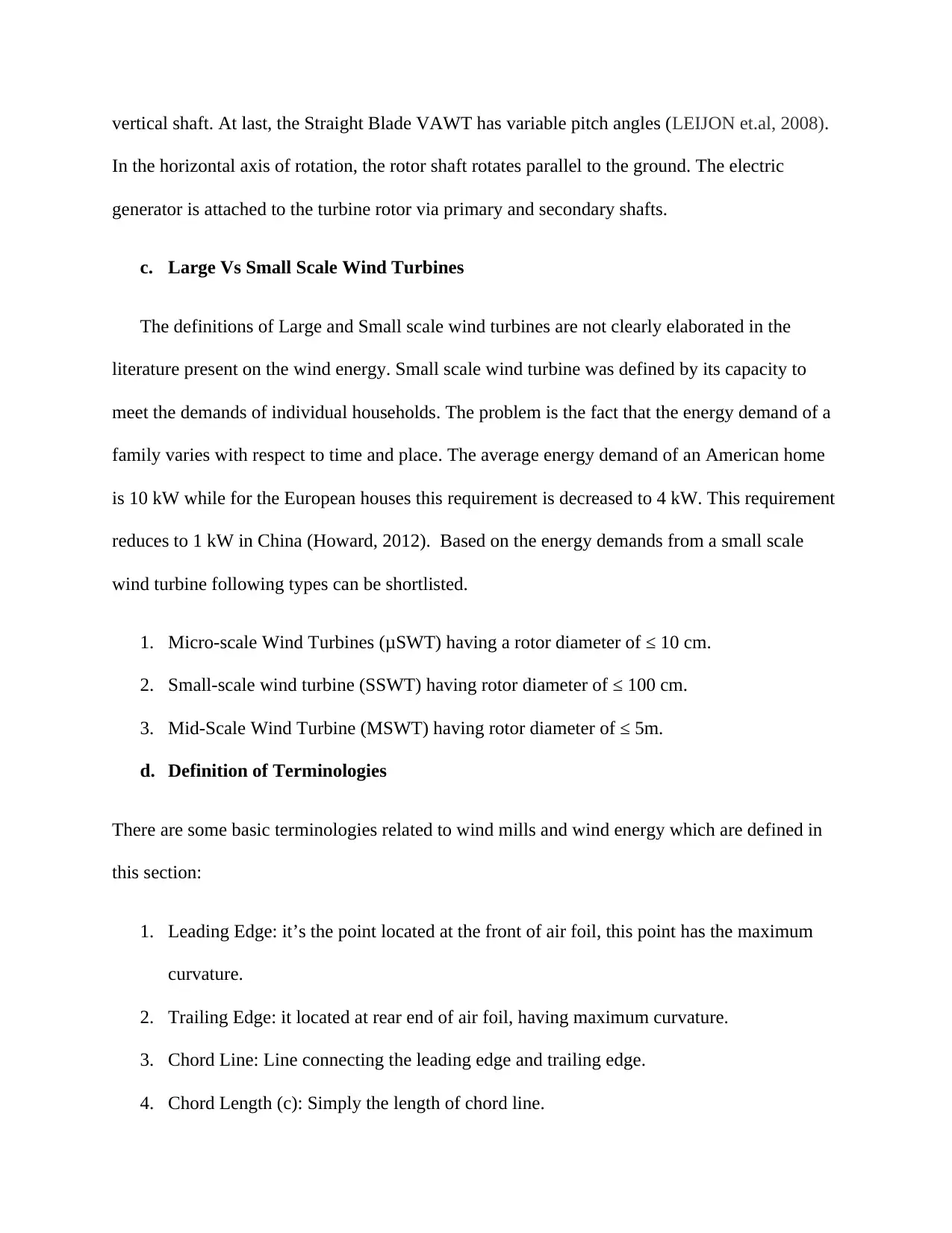
vertical shaft. At last, the Straight Blade VAWT has variable pitch angles (LEIJON et.al, 2008).
In the horizontal axis of rotation, the rotor shaft rotates parallel to the ground. The electric
generator is attached to the turbine rotor via primary and secondary shafts.
c. Large Vs Small Scale Wind Turbines
The definitions of Large and Small scale wind turbines are not clearly elaborated in the
literature present on the wind energy. Small scale wind turbine was defined by its capacity to
meet the demands of individual households. The problem is the fact that the energy demand of a
family varies with respect to time and place. The average energy demand of an American home
is 10 kW while for the European houses this requirement is decreased to 4 kW. This requirement
reduces to 1 kW in China (Howard, 2012). Based on the energy demands from a small scale
wind turbine following types can be shortlisted.
1. Micro-scale Wind Turbines (μSWT) having a rotor diameter of ≤ 10 cm.
2. Small-scale wind turbine (SSWT) having rotor diameter of ≤ 100 cm.
3. Mid-Scale Wind Turbine (MSWT) having rotor diameter of ≤ 5m.
d. Definition of Terminologies
There are some basic terminologies related to wind mills and wind energy which are defined in
this section:
1. Leading Edge: it’s the point located at the front of air foil, this point has the maximum
curvature.
2. Trailing Edge: it located at rear end of air foil, having maximum curvature.
3. Chord Line: Line connecting the leading edge and trailing edge.
4. Chord Length (c): Simply the length of chord line.
In the horizontal axis of rotation, the rotor shaft rotates parallel to the ground. The electric
generator is attached to the turbine rotor via primary and secondary shafts.
c. Large Vs Small Scale Wind Turbines
The definitions of Large and Small scale wind turbines are not clearly elaborated in the
literature present on the wind energy. Small scale wind turbine was defined by its capacity to
meet the demands of individual households. The problem is the fact that the energy demand of a
family varies with respect to time and place. The average energy demand of an American home
is 10 kW while for the European houses this requirement is decreased to 4 kW. This requirement
reduces to 1 kW in China (Howard, 2012). Based on the energy demands from a small scale
wind turbine following types can be shortlisted.
1. Micro-scale Wind Turbines (μSWT) having a rotor diameter of ≤ 10 cm.
2. Small-scale wind turbine (SSWT) having rotor diameter of ≤ 100 cm.
3. Mid-Scale Wind Turbine (MSWT) having rotor diameter of ≤ 5m.
d. Definition of Terminologies
There are some basic terminologies related to wind mills and wind energy which are defined in
this section:
1. Leading Edge: it’s the point located at the front of air foil, this point has the maximum
curvature.
2. Trailing Edge: it located at rear end of air foil, having maximum curvature.
3. Chord Line: Line connecting the leading edge and trailing edge.
4. Chord Length (c): Simply the length of chord line.
Paraphrase This Document
Need a fresh take? Get an instant paraphrase of this document with our AI Paraphraser
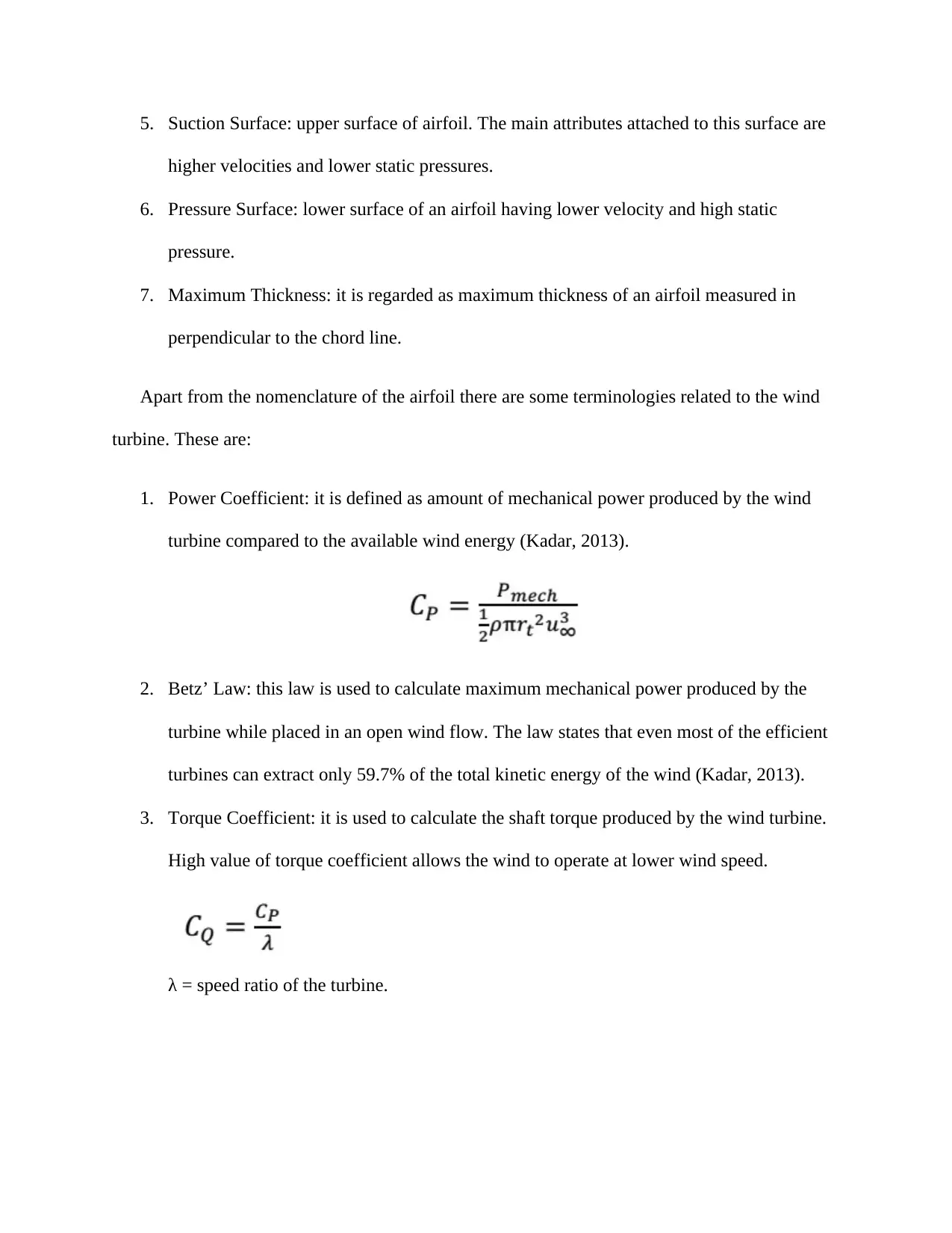
5. Suction Surface: upper surface of airfoil. The main attributes attached to this surface are
higher velocities and lower static pressures.
6. Pressure Surface: lower surface of an airfoil having lower velocity and high static
pressure.
7. Maximum Thickness: it is regarded as maximum thickness of an airfoil measured in
perpendicular to the chord line.
Apart from the nomenclature of the airfoil there are some terminologies related to the wind
turbine. These are:
1. Power Coefficient: it is defined as amount of mechanical power produced by the wind
turbine compared to the available wind energy (Kadar, 2013).
2. Betz’ Law: this law is used to calculate maximum mechanical power produced by the
turbine while placed in an open wind flow. The law states that even most of the efficient
turbines can extract only 59.7% of the total kinetic energy of the wind (Kadar, 2013).
3. Torque Coefficient: it is used to calculate the shaft torque produced by the wind turbine.
High value of torque coefficient allows the wind to operate at lower wind speed.
λ = speed ratio of the turbine.
higher velocities and lower static pressures.
6. Pressure Surface: lower surface of an airfoil having lower velocity and high static
pressure.
7. Maximum Thickness: it is regarded as maximum thickness of an airfoil measured in
perpendicular to the chord line.
Apart from the nomenclature of the airfoil there are some terminologies related to the wind
turbine. These are:
1. Power Coefficient: it is defined as amount of mechanical power produced by the wind
turbine compared to the available wind energy (Kadar, 2013).
2. Betz’ Law: this law is used to calculate maximum mechanical power produced by the
turbine while placed in an open wind flow. The law states that even most of the efficient
turbines can extract only 59.7% of the total kinetic energy of the wind (Kadar, 2013).
3. Torque Coefficient: it is used to calculate the shaft torque produced by the wind turbine.
High value of torque coefficient allows the wind to operate at lower wind speed.
λ = speed ratio of the turbine.
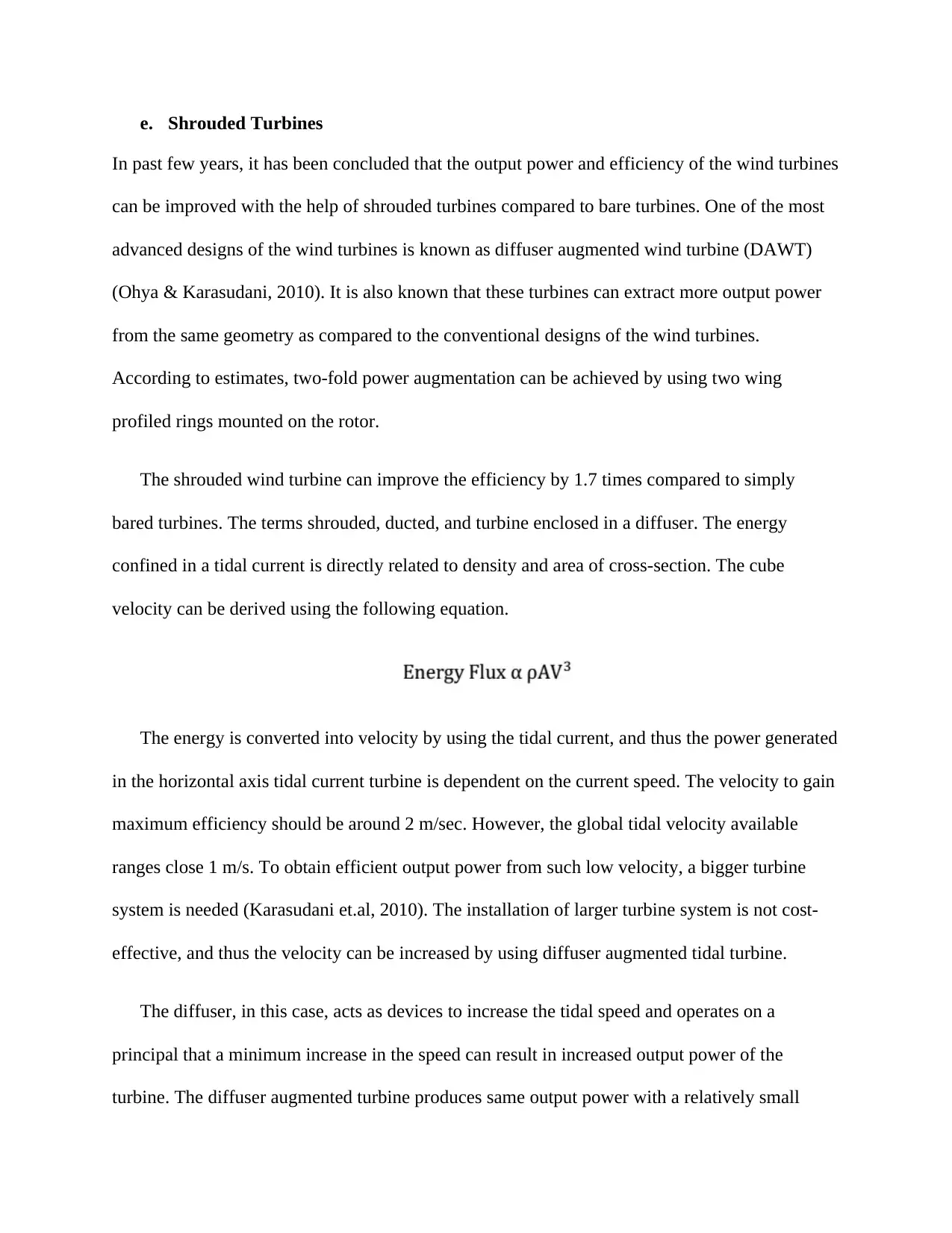
e. Shrouded Turbines
In past few years, it has been concluded that the output power and efficiency of the wind turbines
can be improved with the help of shrouded turbines compared to bare turbines. One of the most
advanced designs of the wind turbines is known as diffuser augmented wind turbine (DAWT)
(Ohya & Karasudani, 2010). It is also known that these turbines can extract more output power
from the same geometry as compared to the conventional designs of the wind turbines.
According to estimates, two-fold power augmentation can be achieved by using two wing
profiled rings mounted on the rotor.
The shrouded wind turbine can improve the efficiency by 1.7 times compared to simply
bared turbines. The terms shrouded, ducted, and turbine enclosed in a diffuser. The energy
confined in a tidal current is directly related to density and area of cross-section. The cube
velocity can be derived using the following equation.
The energy is converted into velocity by using the tidal current, and thus the power generated
in the horizontal axis tidal current turbine is dependent on the current speed. The velocity to gain
maximum efficiency should be around 2 m/sec. However, the global tidal velocity available
ranges close 1 m/s. To obtain efficient output power from such low velocity, a bigger turbine
system is needed (Karasudani et.al, 2010). The installation of larger turbine system is not cost-
effective, and thus the velocity can be increased by using diffuser augmented tidal turbine.
The diffuser, in this case, acts as devices to increase the tidal speed and operates on a
principal that a minimum increase in the speed can result in increased output power of the
turbine. The diffuser augmented turbine produces same output power with a relatively small
In past few years, it has been concluded that the output power and efficiency of the wind turbines
can be improved with the help of shrouded turbines compared to bare turbines. One of the most
advanced designs of the wind turbines is known as diffuser augmented wind turbine (DAWT)
(Ohya & Karasudani, 2010). It is also known that these turbines can extract more output power
from the same geometry as compared to the conventional designs of the wind turbines.
According to estimates, two-fold power augmentation can be achieved by using two wing
profiled rings mounted on the rotor.
The shrouded wind turbine can improve the efficiency by 1.7 times compared to simply
bared turbines. The terms shrouded, ducted, and turbine enclosed in a diffuser. The energy
confined in a tidal current is directly related to density and area of cross-section. The cube
velocity can be derived using the following equation.
The energy is converted into velocity by using the tidal current, and thus the power generated
in the horizontal axis tidal current turbine is dependent on the current speed. The velocity to gain
maximum efficiency should be around 2 m/sec. However, the global tidal velocity available
ranges close 1 m/s. To obtain efficient output power from such low velocity, a bigger turbine
system is needed (Karasudani et.al, 2010). The installation of larger turbine system is not cost-
effective, and thus the velocity can be increased by using diffuser augmented tidal turbine.
The diffuser, in this case, acts as devices to increase the tidal speed and operates on a
principal that a minimum increase in the speed can result in increased output power of the
turbine. The diffuser augmented turbine produces same output power with a relatively small
⊘ This is a preview!⊘
Do you want full access?
Subscribe today to unlock all pages.

Trusted by 1+ million students worldwide
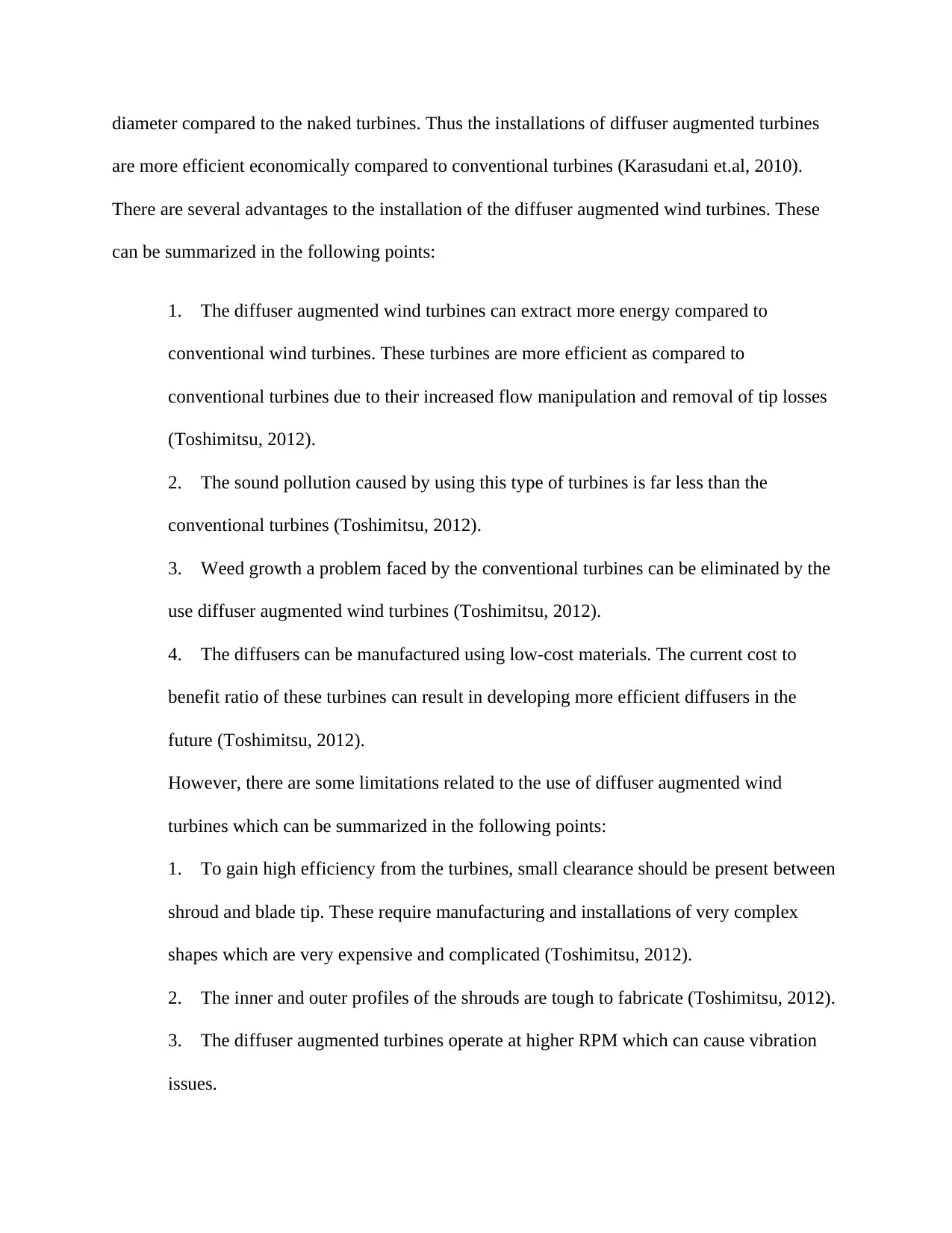
diameter compared to the naked turbines. Thus the installations of diffuser augmented turbines
are more efficient economically compared to conventional turbines (Karasudani et.al, 2010).
There are several advantages to the installation of the diffuser augmented wind turbines. These
can be summarized in the following points:
1. The diffuser augmented wind turbines can extract more energy compared to
conventional wind turbines. These turbines are more efficient as compared to
conventional turbines due to their increased flow manipulation and removal of tip losses
(Toshimitsu, 2012).
2. The sound pollution caused by using this type of turbines is far less than the
conventional turbines (Toshimitsu, 2012).
3. Weed growth a problem faced by the conventional turbines can be eliminated by the
use diffuser augmented wind turbines (Toshimitsu, 2012).
4. The diffusers can be manufactured using low-cost materials. The current cost to
benefit ratio of these turbines can result in developing more efficient diffusers in the
future (Toshimitsu, 2012).
However, there are some limitations related to the use of diffuser augmented wind
turbines which can be summarized in the following points:
1. To gain high efficiency from the turbines, small clearance should be present between
shroud and blade tip. These require manufacturing and installations of very complex
shapes which are very expensive and complicated (Toshimitsu, 2012).
2. The inner and outer profiles of the shrouds are tough to fabricate (Toshimitsu, 2012).
3. The diffuser augmented turbines operate at higher RPM which can cause vibration
issues.
are more efficient economically compared to conventional turbines (Karasudani et.al, 2010).
There are several advantages to the installation of the diffuser augmented wind turbines. These
can be summarized in the following points:
1. The diffuser augmented wind turbines can extract more energy compared to
conventional wind turbines. These turbines are more efficient as compared to
conventional turbines due to their increased flow manipulation and removal of tip losses
(Toshimitsu, 2012).
2. The sound pollution caused by using this type of turbines is far less than the
conventional turbines (Toshimitsu, 2012).
3. Weed growth a problem faced by the conventional turbines can be eliminated by the
use diffuser augmented wind turbines (Toshimitsu, 2012).
4. The diffusers can be manufactured using low-cost materials. The current cost to
benefit ratio of these turbines can result in developing more efficient diffusers in the
future (Toshimitsu, 2012).
However, there are some limitations related to the use of diffuser augmented wind
turbines which can be summarized in the following points:
1. To gain high efficiency from the turbines, small clearance should be present between
shroud and blade tip. These require manufacturing and installations of very complex
shapes which are very expensive and complicated (Toshimitsu, 2012).
2. The inner and outer profiles of the shrouds are tough to fabricate (Toshimitsu, 2012).
3. The diffuser augmented turbines operate at higher RPM which can cause vibration
issues.
Paraphrase This Document
Need a fresh take? Get an instant paraphrase of this document with our AI Paraphraser
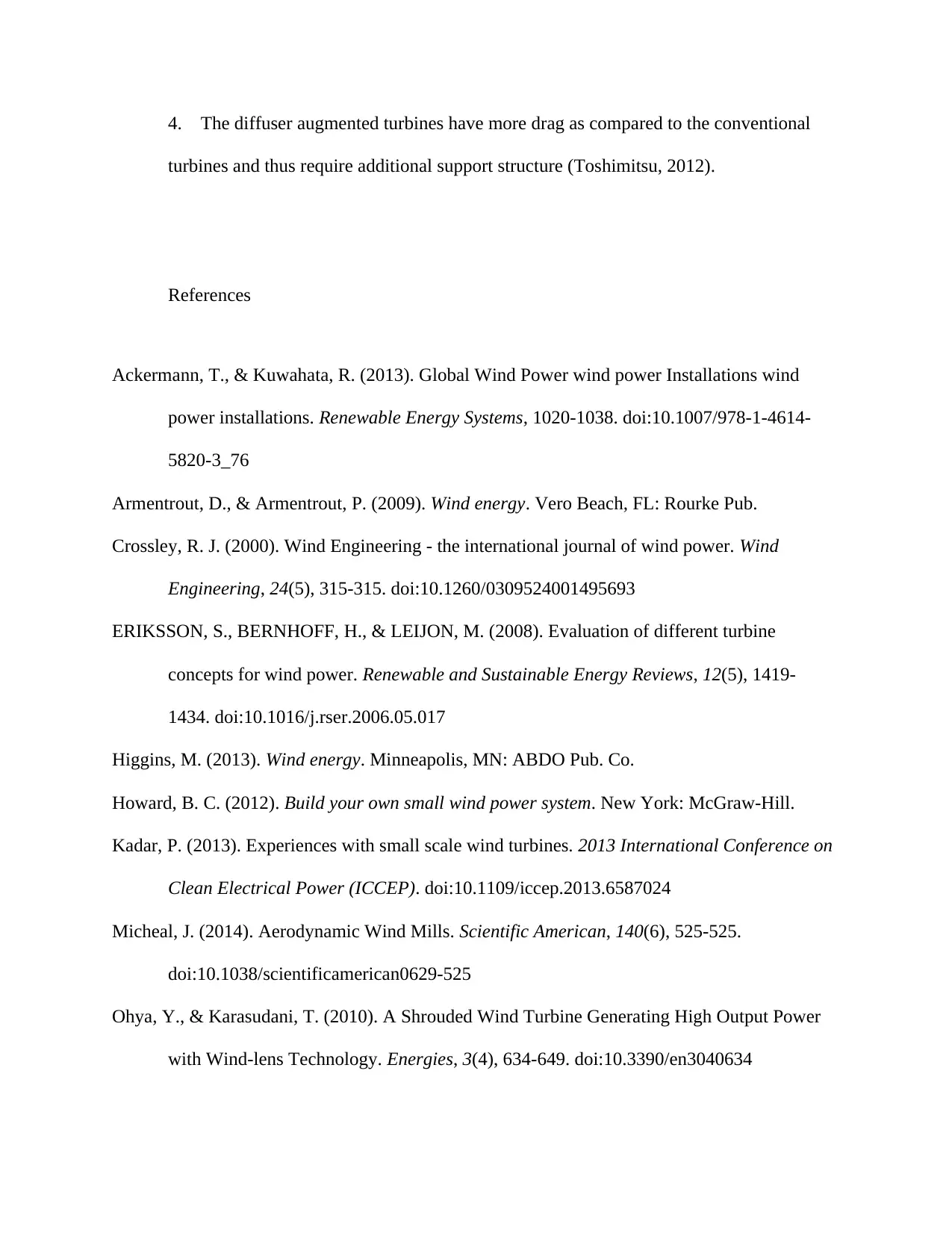
4. The diffuser augmented turbines have more drag as compared to the conventional
turbines and thus require additional support structure (Toshimitsu, 2012).
References
Ackermann, T., & Kuwahata, R. (2013). Global Wind Power wind power Installations wind
power installations. Renewable Energy Systems, 1020-1038. doi:10.1007/978-1-4614-
5820-3_76
Armentrout, D., & Armentrout, P. (2009). Wind energy. Vero Beach, FL: Rourke Pub.
Crossley, R. J. (2000). Wind Engineering - the international journal of wind power. Wind
Engineering, 24(5), 315-315. doi:10.1260/0309524001495693
ERIKSSON, S., BERNHOFF, H., & LEIJON, M. (2008). Evaluation of different turbine
concepts for wind power. Renewable and Sustainable Energy Reviews, 12(5), 1419-
1434. doi:10.1016/j.rser.2006.05.017
Higgins, M. (2013). Wind energy. Minneapolis, MN: ABDO Pub. Co.
Howard, B. C. (2012). Build your own small wind power system. New York: McGraw-Hill.
Kadar, P. (2013). Experiences with small scale wind turbines. 2013 International Conference on
Clean Electrical Power (ICCEP). doi:10.1109/iccep.2013.6587024
Micheal, J. (2014). Aerodynamic Wind Mills. Scientific American, 140(6), 525-525.
doi:10.1038/scientificamerican0629-525
Ohya, Y., & Karasudani, T. (2010). A Shrouded Wind Turbine Generating High Output Power
with Wind-lens Technology. Energies, 3(4), 634-649. doi:10.3390/en3040634
turbines and thus require additional support structure (Toshimitsu, 2012).
References
Ackermann, T., & Kuwahata, R. (2013). Global Wind Power wind power Installations wind
power installations. Renewable Energy Systems, 1020-1038. doi:10.1007/978-1-4614-
5820-3_76
Armentrout, D., & Armentrout, P. (2009). Wind energy. Vero Beach, FL: Rourke Pub.
Crossley, R. J. (2000). Wind Engineering - the international journal of wind power. Wind
Engineering, 24(5), 315-315. doi:10.1260/0309524001495693
ERIKSSON, S., BERNHOFF, H., & LEIJON, M. (2008). Evaluation of different turbine
concepts for wind power. Renewable and Sustainable Energy Reviews, 12(5), 1419-
1434. doi:10.1016/j.rser.2006.05.017
Higgins, M. (2013). Wind energy. Minneapolis, MN: ABDO Pub. Co.
Howard, B. C. (2012). Build your own small wind power system. New York: McGraw-Hill.
Kadar, P. (2013). Experiences with small scale wind turbines. 2013 International Conference on
Clean Electrical Power (ICCEP). doi:10.1109/iccep.2013.6587024
Micheal, J. (2014). Aerodynamic Wind Mills. Scientific American, 140(6), 525-525.
doi:10.1038/scientificamerican0629-525
Ohya, Y., & Karasudani, T. (2010). A Shrouded Wind Turbine Generating High Output Power
with Wind-lens Technology. Energies, 3(4), 634-649. doi:10.3390/en3040634
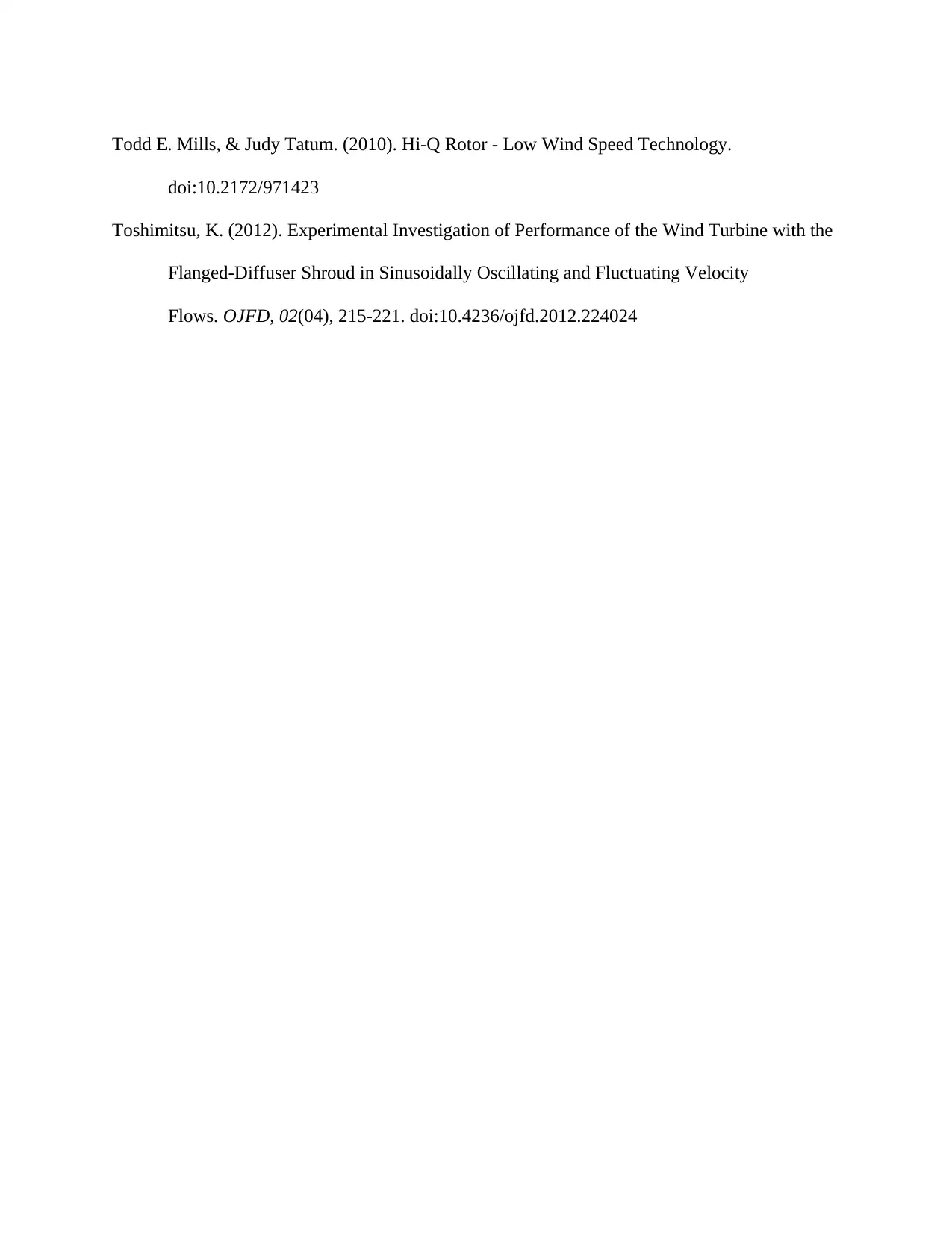
Todd E. Mills, & Judy Tatum. (2010). Hi-Q Rotor - Low Wind Speed Technology.
doi:10.2172/971423
Toshimitsu, K. (2012). Experimental Investigation of Performance of the Wind Turbine with the
Flanged-Diffuser Shroud in Sinusoidally Oscillating and Fluctuating Velocity
Flows. OJFD, 02(04), 215-221. doi:10.4236/ojfd.2012.224024
doi:10.2172/971423
Toshimitsu, K. (2012). Experimental Investigation of Performance of the Wind Turbine with the
Flanged-Diffuser Shroud in Sinusoidally Oscillating and Fluctuating Velocity
Flows. OJFD, 02(04), 215-221. doi:10.4236/ojfd.2012.224024
⊘ This is a preview!⊘
Do you want full access?
Subscribe today to unlock all pages.

Trusted by 1+ million students worldwide
1 out of 9
Related Documents
Your All-in-One AI-Powered Toolkit for Academic Success.
+13062052269
info@desklib.com
Available 24*7 on WhatsApp / Email
![[object Object]](/_next/static/media/star-bottom.7253800d.svg)
Unlock your academic potential
Copyright © 2020–2025 A2Z Services. All Rights Reserved. Developed and managed by ZUCOL.




